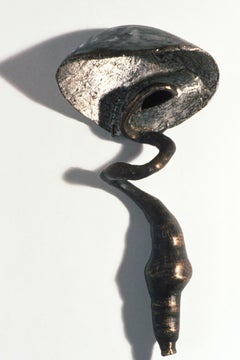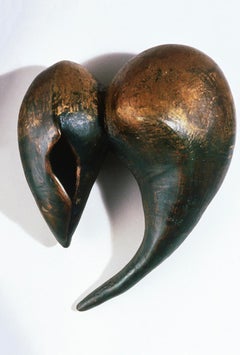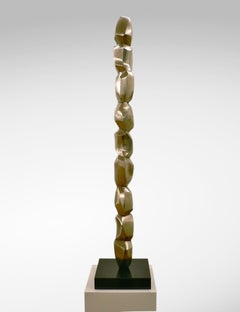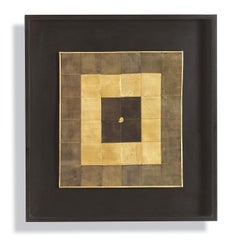Silver Abstract Sculptures
to
1
1
Overall Width
to
Overall Height
to
2
2
2
5
5
2
1
1
3
2
2
1
1
2
Medium: Silver
Artist: Roberley Bell
Lake Erie and Other Waters 02
Located in Buffalo, NY
An original unique bronze and silver leaf abstract sculpture by Roberley Bell.
This dynamic work from the artist's "Lake Erie and Other Waters" series can...
Category
1990s Abstract Silver Abstract Sculptures
Materials
Bronze, Silver
Lake Erie and Other Waters 03
Located in Buffalo, NY
An original unique bronze and silver leaf abstract sculpture by Roberley Bell.
This dynamic work from the artist's "Lake Erie and Other Waters" series can...
Category
1990s Abstract Silver Abstract Sculptures
Materials
Silver, Bronze
Related Items
Bronze Sculpture 'Bolas IV' by Carola Eggeling, Bronze Patina
Located in Paris, FR
Bronze Sculpture 'Bolas IV' by Carola Eggeling
Abstract sculpture with beautiful curved lines.
German bronze sculpture
Bronze Patina
Certific...
Category
21st Century and Contemporary Abstract Silver Abstract Sculptures
Materials
Bronze
$18,309
H 38.19 in W 3.15 in D 3.55 in
"Pojagi Construction II" Jin-Sook So, Contemporary Korean mixed media artwork
By Jin-Sook So
Located in Wilton, CT
This abstract geometric mixed media piece was done by fiber artist, Jin-Sook So (b. 1950, Korea). So grew up in Seoul, Korea where she received a master's degree in textile art, afte...
Category
Early 2000s Abstract Geometric Silver Abstract Sculptures
Materials
Metal, Silver, Steel, Gold Leaf
$6,400
H 21.25 in W 19.75 in D 2.25 in
Rushing
By Robert Cook
Located in New York, NY
Robert Cook’s sculpture Rushing serves as an energetic reflection on the fast-paced nature of life—where so many of us are constantly in motion, hurrying from one place to another. H...
Category
2010s Abstract Silver Abstract Sculptures
Materials
Marble, Bronze
Bronze Sculpture 'Rosenmontagsstele' by Carola Eggeling
Located in Paris, FR
Bronze Sculpture 'Rosenmontagsstele' by Carola Eggeling
Abstract sculpture with beautiful curved lines.
German bronze sculpture
Numbered and signed artwork
Limited edition of 6
Meas...
Category
21st Century and Contemporary Abstract Silver Abstract Sculptures
Materials
Bronze
$34,465
H 71.66 in W 13.78 in D 12.6 in
"I am your Sun, you are my Earth"
Located in Edinburgh, GB
He and She reach for manifestation. He opens the way, She holds the foundation, grounds. He is spirit, She is matter. He is gold, She is silver. They are in the harmony of Creativity...
Category
21st Century and Contemporary Abstract Silver Abstract Sculptures
Materials
Metal, Silver, Iron
Sojourner Series #16
By Bill Barrett
Located in New York, NY
A great small maquette that has a naturalistic form mirroring nature. Works like these by Bill Barrett have long been loved to grace bookshelves, consoles, coffee tables and mantles...
Category
2010s Abstract Silver Abstract Sculptures
Materials
Bronze
"Pojagi Construction I" Jin-Sook So, Contemporary Korean mixed media artwork
By Jin-Sook So
Located in Wilton, CT
This abstract geometric mixed media piece was done by fiber artist, Jin-Sook So (b. 1950, Korea). So grew up in Seoul, Korea where she received a master's degree in textile art, afte...
Category
Early 2000s Abstract Geometric Silver Abstract Sculptures
Materials
Metal, Silver, Steel, Gold Leaf
$6,400
H 21.25 in W 19.75 in D 2.25 in
Silver wall sculpture
Located in Palm Desert, CA
Silver From the series, Elements, this sculpture references the Bolivian mines that produce much of the worlds silver production ARTIST'S STATEMENT Michael Davis My sculptures and...
Category
21st Century and Contemporary Abstract Silver Abstract Sculptures
Materials
Metal, Silver
"Inspiration"
Located in Edinburgh, GB
Masculine inspiration can take many forms and looks different depending on the individual, his personality, energy, and emotional state. But generally speaking, masculine inspiration...
Category
21st Century and Contemporary Abstract Silver Abstract Sculptures
Materials
Metal, Iron, Silver, Copper
Bronze Sculpture “Surrender 8”
By Frank Arnold
Located in Fresno, CA
Frank Arnold is viewed as one of the foremost abstract figurative painters and sculptors of our time. He is a living master guided by a personal mission to “turn on a light in the human soul,” through his passionate creation of “Messengers” from his deeper mind connection with Carl Jung's archetypal images, the collective unconscious, and Jungian Synchronicity. These unconscious forms from his deeper mind resonate as personal messages of universal acceptance, reaching out to the viewer. Arnold has been honored as IAD Artist of the year 2018 by International Artist Day, and 2013 FAC Horizon Artist Award. He has exhibited his artwork in numerous galleries, museums, and is in collections worldwide. Arnold divides his working days between oil painting in San Jose del Cabo, Baja Sur...
Category
21st Century and Contemporary Abstract Silver Abstract Sculptures
Materials
Bronze
Untitled Steel Mesh 2012, Abstract Geometric Wall Sculpture by Jin-Sook So
By Jin-Sook So
Located in Wilton, CT
Untitled Steel Mesh I 2012, Jin-Sook So, steel mesh, painted, electroplated silver and gold leaf, 31.5" x 52.75" x 6.25", 2012.
This abstract geometric wall sculpture was done by fi...
Category
2010s Abstract Geometric Silver Abstract Sculptures
Materials
Silver, Steel, Gold Leaf
$50,000
H 31.5 in W 52.75 in D 6.25 in
Maquette for Laureate (unique sculpture)
Located in New York, NY
Seymour Lipton
Maquette for Laureate, ca. 1968-1969
Nickel silver on monel metal
Unique
18 × 8 1/2 × 7 inches
Marlborough-Gerson Gallery, New York
Acquired from the above by the previous owner, 1969
thence by descent
Christie's New York: Monday, June 30, 2008 [Lot 00199]
Acquired from the above Christie's sale This unique sculpture by important Abstract Expressionist sculptor Seymour Lipton is a maquette of the monumental sculpture "Laureate" - one of Lipton's most iconic and influential works located on the Riverwalk in downtown Milwaukee, Wisconsin. Laureate is a masterpiece that was commissioned by the Allen-Bradley Company in memory of Harry Lynde Bradley and as an enhancement for the newly constructed Performing Arts Center. It is located on the east bank of the Milwaukee River at 929 North Water Street. The Bradley family in Milwaukee were renowned patrons of modernist sculpture, known for their excellent taste who also founded an eponymous sculpture park. For reference only is an image of the monumental "Laureate" one of Milwaukee's most beloved public sculptures. According to the Smithsonian, which owns a different unique variation of this work, "The full-size sculpture Laureate was commissioned by the Marcus Center for the Performing Arts in Milwaukee. In the initial drawings, Seymour Lipton combined details from the architectural plan with a wide variety of images, ranging from musical instruments to a lighthouse on the island of Tobago. He transformed the basic shapes from these sketches into a welded sculpture, which evokes a figure composed of columns, harp strings, and coiled rope. Lipton created this piece to celebrate achievement in the arts. The dramatic silhouette commands your attention, reflecting the title Laureate, which means worthy of honor and distinction. The final version of the piece is over twelve feet high and stands out against the pale, flat buildings of the arts center.,,"
Provenance
Marlborough-Gerson Gallery, New York
Acquired from the above by the previous owner, 1969
thence by descent
Christie's New York: Monday, June 30, 2008 [Lot 00199]
Acquired from the above Christie's sale
About Seymour Lipton:
Born in New York City in 1903, Seymour Lipton (1903-1986) grew up in a Bronx tenement at a time when much of the borough was still farmland. These rural surroundings enabled Lipton to explore the botanical and animal forms that would later become sources for his work. Lipton’s interest in the dialogue between artistic creation and natural phenomena was nurtured by a supportive family and cultivated through numerous visits to New York’s Museum of Natural History as well as its many botanical gardens and its zoos. In the early 1920s, with the encouragement of his family, Lipton studied electrical engineering at Brooklyn Polytechnic Institute and pursued a liberal arts education at City College. Ultimately, like fellow sculptor Herbert Ferber, Lipton became a dentist, receiving his degree from Columbia University in 1927. In the late 1920s, he began to explore sculpture, creating clay portraits of family members and friends.
In addition to providing him with financial security, dentistry gave Lipton a foundation in working with metal, a material he would later use in his artwork. In the early 1930s, though, Lipton’s primary sculptural medium was wood. Lipton led a comfortable life, but he was also aware of the economic and psychological devastation the Depression had caused New York. In response, he generally worked using direct carving techniques—a form of sculpting where the artist “finds” the sculpture within the wood in the process of carving it and without the use of models and maquettes. The immediacy of this practice enabled Lipton to create a rich, emotional and visual language with which to articulate the desperation of the downtrodden and the unwavering strength of the disenfranchised. In 1935, he exhibited one such early sculpture at the John Reed Club Gallery in New York, and three years later, ACA Gallery mounted Lipton’s first solo show, which featured these social-realist-inspired wooden works. In 1940, this largely self-taught artist began teaching sculpture at the New School for Social Research, a position he held until 1965.
In the 1940s, Lipton began to devote an increasing amount of time to his art, deviating from wood and working with brass, lead, and bronze. Choosing these metals for their visual simplicity, which he believed exemplified the universal heroism of the “everyman,” Lipton could also now explore various forms of abstraction. Lipton’s turn towards increasing abstraction in the 1940s allowed him to fully develop his metaphorical style, which in turn gave him a stronger lexicon for representing the horrors of World War II and questioning the ambiguities of human experience. He began his metal work with cast bronze sculptures, but, in 1946, he started welding sheet metal and lead. Lipton preferred welding because, as direct carving did with wood, this approach allowed “a more direct contact with the metal.”[ii] From this, Lipton developed the technique he would use for the remainder of his career: “He cut sheet metal, manipulated it to the desired shapes, then joined, soldered, or welded the pieces together. Next, he brazed a metal coating to the outside to produce a uniform texture.”[iii]
In 1950, Lipton arrived at his mature style of brazing on Monel metal. He also began to draw extensively, exploring the automatism that abstract expressionist painters were boasting at the time. Like contemporaries such as Jackson Pollock, Lipton was strongly influenced by Carl Jung’s work on the unconscious mind and the regenerative forces of nature. He translated these two-dimensional drawings into three-dimensional maquettes that enabled him to revise his ideas before creating the final sculpture.The forms that Lipton produced during this period were often zoomorphic, exemplifying the tension between the souls of nature and the automatism of the machine.
In the years following the 1950s, Lipton’s optimism began to rise, and the size of his work grew in proportion. The oxyacetylene torch—invented during the Second World War—allowed him to rework the surfaces of metal sculptures, thus eliminating some of the risks involved with producing large-scale finished works. In 1958, Lipton was awarded a solo exhibition at the Venice Biennale and was thus internationally recognized as part of a small group of highly regarded avant-garde constructivist sculptors. In 1960, he received a prestigious Guggenheim Award, which was followed by several prominent public commissions, including his heroic Archangel, currently residing in Lincoln Center’s David Geffen Hall.
A number of important solo exhibitions of his work followed at The Phillips Collection in Washington, DC (1964); the Milwaukee Art Center and University of Wisconsin, Milwaukee (1969); the Virginia Museum of Fine Arts in Richmond (1972); the Everson Museum in Syracuse, NY (1973); the Herbert E. Johnson Museum of Art of Cornell University in Ithaca, NY (1973); the National Collection of Fine Arts, Smithsonian Institution (now the Smithsonian American Art Museum) in Washington, DC (1978); and a retrospective in 1979 at The Jewish Museum in New York. In 1982 and 1984 alone, two exhibitions of his sculpture, organized respectively by the Mint Museum (Charlotte, NC) and the Hillwood Art Gallery of Long Island University (Greenvale, NY), traveled extensively across museums and university galleries around the nation. In 2000, the traveling exhibition An American Sculptor: Seymour Lipton was first presented by the Palmer Museum of Art of Pennsylvania State University in University Park. Most recently, in 2009, the Ackland Art Museum in Chapel Hill, NC mounted The Guardian and the Avant-Garde: Seymour Lipton’s Sentinel II in Context.
Since 2004, Michael Rosenfeld Gallery has been the exclusive representative of the Estate of Seymour Lipton and has presented two solo exhibitions of his work—Seymour Lipton: Abstract Expressionist Sculptor (2005) and Seymour Lipton: Metal (2008). In 2013, Michael Rosenfeld Gallery presented Abstract Expressionism, In Context: Seymour Lipton, which included twelve major sculptures by the artist, along with works by Charles Alston, Norman Bluhm, Beauford Delaney, Willem de Kooning, Jay DeFeo, Michael Goldberg, Adolph Gottlieb, Hans Hofmann, Lee Krasner, Norman Lewis, Conrad Marca-Relli, Boris Margo, Alfonso Ossorio, Richard Pousette-Dart, Milton Resnick, Charles Seliger...
Category
1960s Abstract Expressionist Silver Abstract Sculptures
Materials
Metal, Silver
Silver abstract sculptures for sale on 1stDibs.
Find a wide variety of authentic Silver abstract sculptures available on 1stDibs. While artists have worked in this medium across a range of time periods, art made with this material during the 21st Century is especially popular. If you’re looking to add Abstract sculptures created with this material to introduce a provocative pop of color and texture to an otherwise neutral space in your home, the works available on 1stDibs include elements of orange, red and other colors. There are many well-known artists whose body of work includes ceramic sculptures. Popular artists on 1stDibs associated with pieces like this include Carola Eggeling, Joel Urruty, Roberley Bell, and Lucy Kinsella. Frequently made by artists working in the Abstract, Contemporary, all of these pieces for sale are unique and many will draw the attention of guests in your home. Not every interior allows for large Silver abstract sculptures, so small editions measuring 0.25 inches across are also available
Recently Viewed
View AllMore Ways To Browse
Old English Horse
Old Man Chair
Old World Landscape Painting
Olga Alexandrovna
Olivier Lavorel
On Kawara
Orazio Gentileschi
Original Vintage Bullfight Posters
Oskar Bergman
Otto Altenkirch
Otto Stark
Otto Van Veen
Oval Dog Painting
P English Paintings
Paddle Board Painting
Painting By J Philippe
Painting By Numbers Vintage
Painting By Whipple



